check engine light Citroen JUMPER DAG 2008 2.G User Guide
[x] Cancel search | Manufacturer: CITROEN, Model Year: 2008, Model line: JUMPER DAG, Model: Citroen JUMPER DAG 2008 2.GPages: 163, PDF Size: 2.74 MB
Page 110 of 163
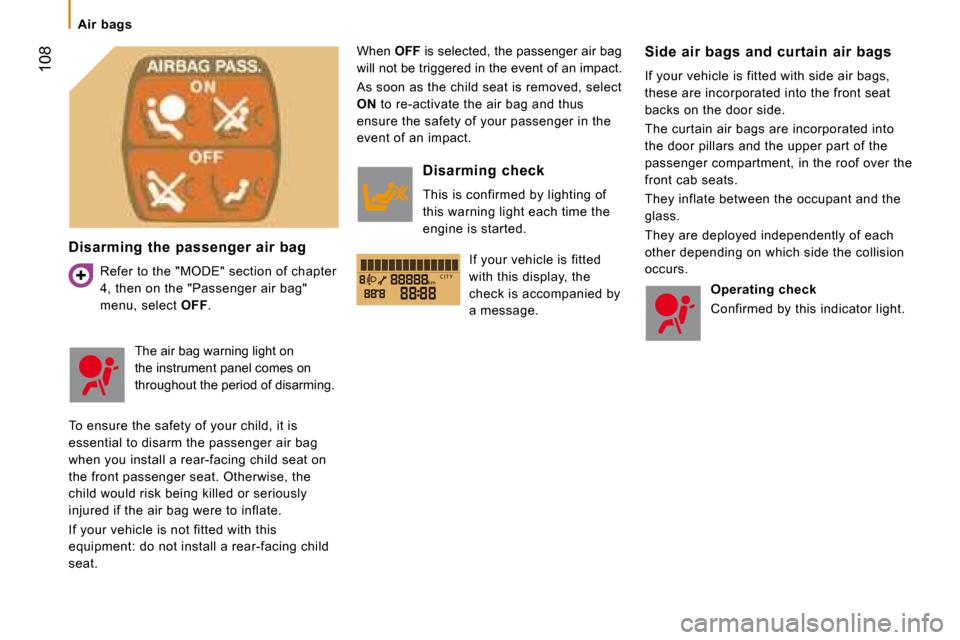
kmC I T Y
108
Air bags
Disarming the passenger air bag Refer to the "MODE" section of chapter
4, then on the "Passenger air bag"
menu, select OFF . When
OFF is selected, the passenger air bag
will not be triggered in the event of an impact.
As soon as the child seat is removed, select
ON to re-activate the air bag and thus
ensure the safety of your passenger in the
event of an impact. Side air bags and curtain air bags
If your vehicle is fitted with side air bags,
these are incorporated into the front seat
backs on the door side.
The curtain air bags are incorporated into
the door pillars and the upper part of the
passenger compartment, in the roof over the
front cab seats.
They inflate between the occupant and the
glass.
They are deployed independently of each
other depending on which side the collision
occurs.
The air bag warning light on
the instrument panel comes on
throughout the period of disarming.
To ensure the safety of your child, it is
essential to disarm the passenger air bag
when you install a rear-facing child seat on
the front passenger seat. Otherwise, the
child would risk being killed or seriously
injured if the air bag were to inflate.
If your vehicle is not fitted with this
equipment: do not install a rear-facing child
seat. Disarming check
This is confirmed by lighting of
this warning light each time the
engine is started.
If your vehicle is fitted
with this display, the
check is accompanied by
a message. Operating check
Confirmed by this indicator light.
Page 120 of 163
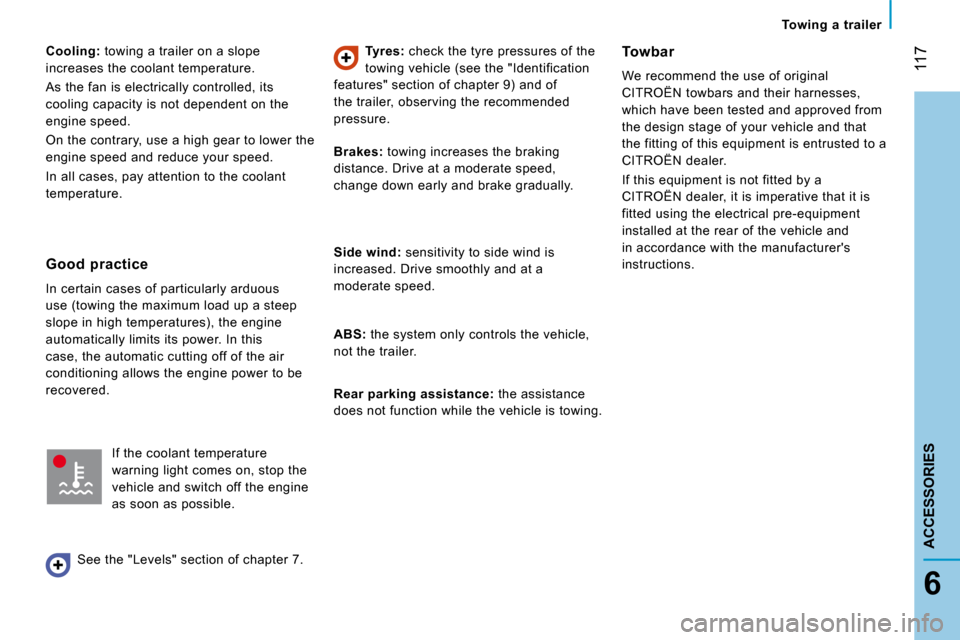
117
6
ACCESSORIES
Towing a trailer
Cooling: towing a trailer on a slope
increases the coolant temperature.
As the fan is electrically controlled, its
cooling capacity is not dependent on the
engine speed.
On the contrary, use a high gear to lower the
engine speed and reduce your speed.
In all cases, pay attention to the coolant
temperature.
Tyres: check the tyre pressures of the
towing vehicle (see the "Identification
features" section of chapter 9) and of
the trailer, observing the recommended
pressure. Towbar
We recommend the use of original
CITROËN towbars and their harnesses,
which have been tested and approved from
the design stage of your vehicle and that
the fitting of this equipment is entrusted to a
CITROËN dealer.
If this equipment is not fitted by a
CITROËN dealer, it is imperative that it is
fitted using the electrical pre-equipment
installed at the rear of the vehicle and
in accordance with the manufacturer's
instructions.
Good practice
In certain cases of particularly arduous
use (towing the maximum load up a steep
slope in high temperatures), the engine
automatically limits its power. In this
case, the automatic cutting off of the air
conditioning allows the engine power to be
recovered.
If the coolant temperature
warning light comes on, stop the
vehicle and switch off the engine
as soon as possible.
See the "Levels" section of chapter 7.
Brakes: towing increases the braking
distance. Drive at a moderate speed,
change down early and brake gradually.
Side wind: sensitivity to side wind is
increased. Drive smoothly and at a
moderate speed.
ABS: the system only controls the vehicle,
not the trailer.
Rear parking assistance: the assistance
does not function while the vehicle is towing.
Page 124 of 163
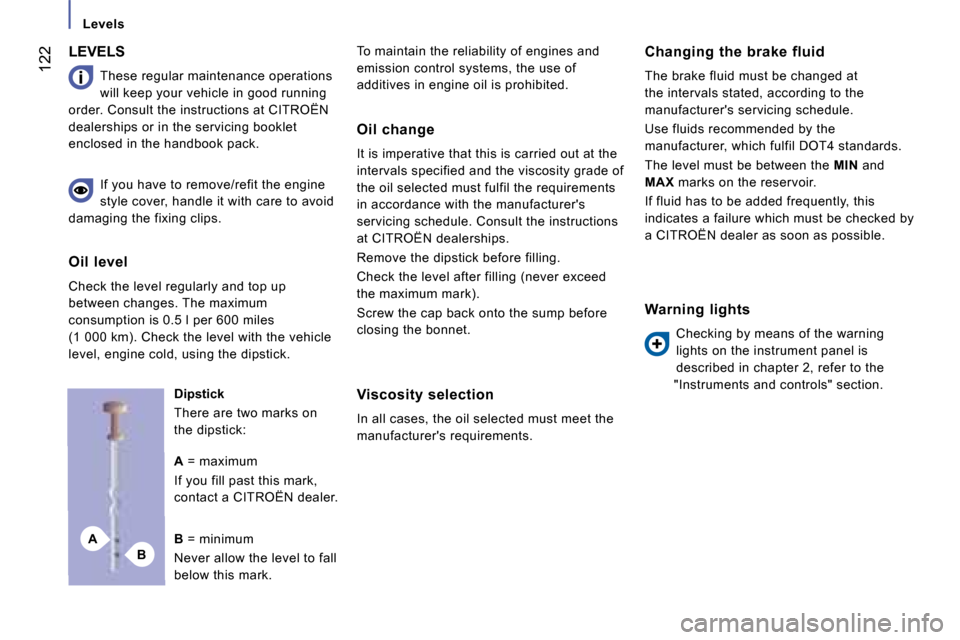
BA
122
Levels
LEVELS
These regular maintenance operations
will keep your vehicle in good running
order. Consult the instructions at CITROËN
dealerships or in the servicing booklet
enclosed in the handbook pack. To maintain the reliability of engines and
emission control systems, the use of
additives in engine oil is prohibited.
Changing the brake fluid
The brake fluid must be changed at
the intervals stated, according to the
manufacturer's servicing schedule.
Use fluids recommended by the
manufacturer, which fulfil DOT4 standards.
The level must be between the
MIN and
MAX marks on the reservoir.
If fluid has to be added frequently, this
indicates a failure which must be checked by
a CITROËN dealer as soon as possible.
If you have to remove/refit the engine
style cover, handle it with care to avoid
damaging the fixing clips.
Dipstick
There are two marks on
the dipstick: Oil change
It is imperative that this is carried out at the
intervals specified and the viscosity grade of
the oil selected must fulfil the requirements
in accordance with the manufacturer's
servicing schedule. Consult the instructions
at CITROËN dealerships.
Remove the dipstick before filling.
Check the level after filling (never exceed
the maximum mark).
Screw the cap back onto the sump before
closing the bonnet.
Viscosity selection
In all cases, the oil selected must meet the
manufacturer's requirements.
Warning lights
Checking by means of the warning
lights on the instrument panel is
described in chapter 2, refer to the
"Instruments and controls" section.
A = maximum
If you fill past this mark,
contact a CITROËN dealer.
B = minimum
Never allow the level to fall
below this mark.
Oil level
Check the level regularly and top up
between changes. The maximum
consumption is 0.5 l per 600 miles
(1 000 km). Check the level with the vehicle
level, engine cold, using the dipstick.
Page 126 of 163
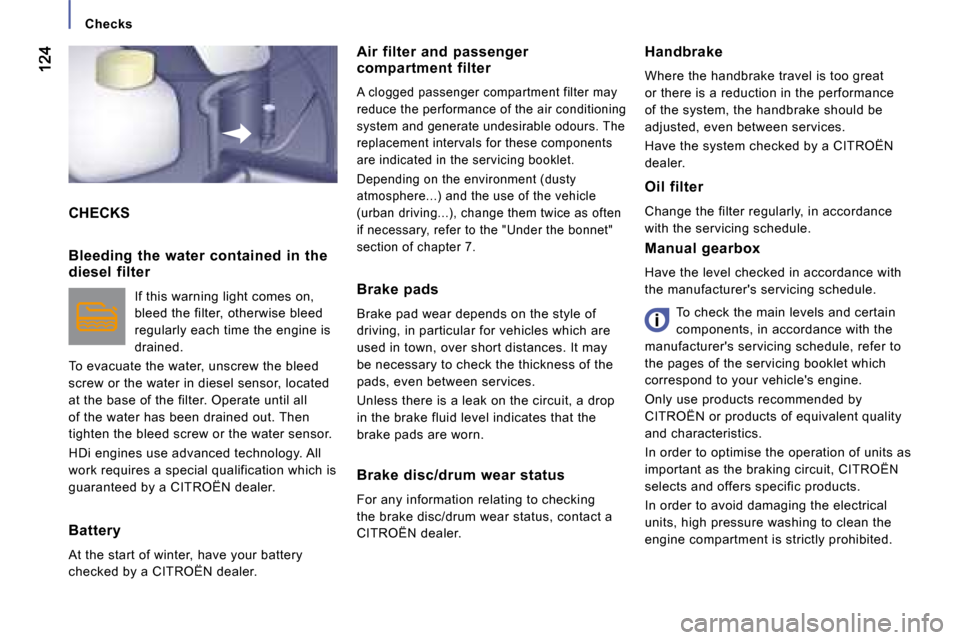
Checks
CHECKS
Air filter and passenger
compartment filter
A clogged passenger compartment filter may
reduce the performance of the air conditioning
system and generate undesirable odours. The
replacement intervals for these components
are indicated in the servicing booklet.
Depending on the environment (dusty
atmosphere...) and the use of the vehicle
(urban driving...), change them twice as often
if necessary, refer to the "Under the bonnet"
section of chapter 7.
Manual gearbox
Have the level checked in accordance with
the manufacturer's servicing schedule. To check the main levels and certain
components, in accordance with the
manufacturer's servicing schedule, refer to
the pages of the servicing booklet which
correspond to your vehicle's engine.
Only use products recommended by
CITROËN or products of equivalent quality
and characteristics.
In order to optimise the operation of units as
important as the braking circuit, CITROËN
selects and offers specific products.
In order to avoid damaging the electrical
units, high pressure washing to clean the
engine compartment is strictly prohibited.
Handbrake
Where the handbrake travel is too great
or there is a reduction in the performance
of the system, the handbrake should be
adjusted, even between services.
Have the system checked by a CITROËN
dealer.
Bleeding the water contained in the
diesel filter If this warning light comes on,
bleed the filter, otherwise bleed
regularly each time the engine is
drained.
To evacuate the water, unscrew the bleed
screw or the water in diesel sensor, located
at the base of the filter. Operate until all
of the water has been drained out. Then
tighten the bleed screw or the water sensor.
HDi engines use advanced technology. All
work requires a special qualification which is
guaranteed by a CITROËN dealer.
Battery
At the start of winter, have your battery
checked by a CITROËN dealer. Brake pads
Brake pad wear depends on the style of
driving, in particular for vehicles which are
used in town, over short distances. It may
be necessary to check the thickness of the
pads, even between services.
Unless there is a leak on the circuit, a drop
in the brake fluid level indicates that the
brake pads are worn.
Brake disc/drum wear status
For any information relating to checking
the brake disc/drum wear status, contact a
CITROËN dealer. Oil filter
Change the filter regularly, in accordance
with the servicing schedule.
Page 127 of 163
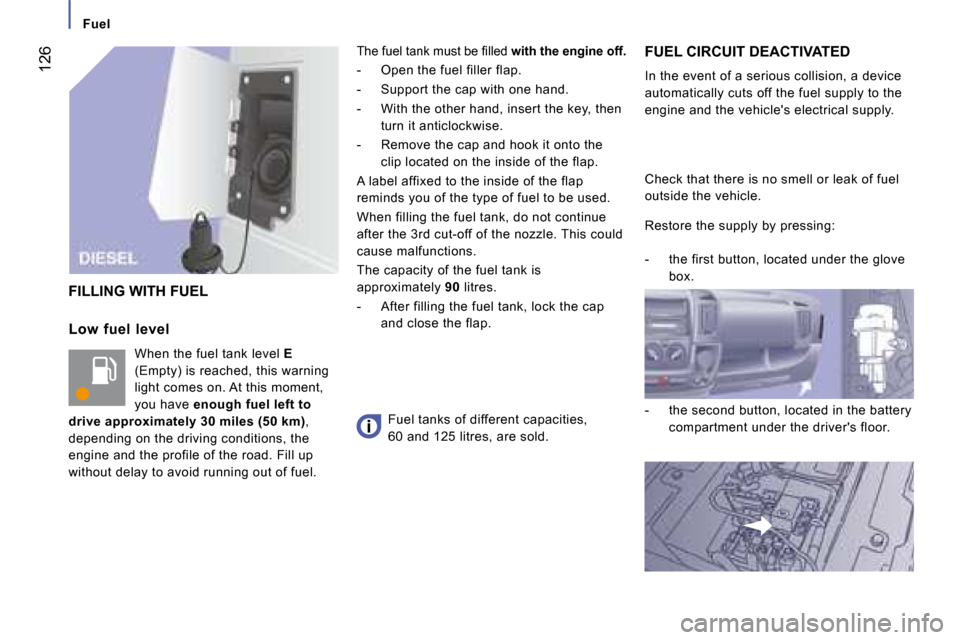
126
Fuel
Low fuel level When the fuel tank level E
(Empty) is reached, this warning
light comes on. At this moment,
you have enough fuel left to
drive approximately 30 miles (50 km) ,
depending on the driving conditions, the
engine and the profile of the road. Fill up
without delay to avoid running out of fuel.
�T�h�e� �f�u�e�l� �t�a�n�k� �m�u�s�t� �b�e� �fi� �l�l�e�d� �
with the engine off.
- Open the fuel filler flap.
- Support the cap with one hand.
- With the other hand, insert the key, then turn it anticlockwise.
- Remove the cap and hook it onto the clip located on the inside of the flap.
A label affixed to the inside of the flap
reminds you of the type of fuel to be used.
When filling the fuel tank, do not continue
after the 3rd cut-off of the nozzle. This could
cause malfunctions.
The capacity of the fuel tank is
approximately 90 litres.
- After filling the fuel tank, lock the cap and close the flap. FUEL CIRCUIT DEACTIVATED
In the event of a serious collision, a device
automatically cuts off the fuel supply to the
engine and the vehicle's electrical supply.
FILLING WITH FUEL
Fuel tanks of different capacities,
60 and 125 litres, are sold. Check that there is no smell or leak of fuel
outside the vehicle.
Restore the supply by pressing:
- the first button, located under the glove
box.
- the second button, located in the battery compartment under the driver's floor.